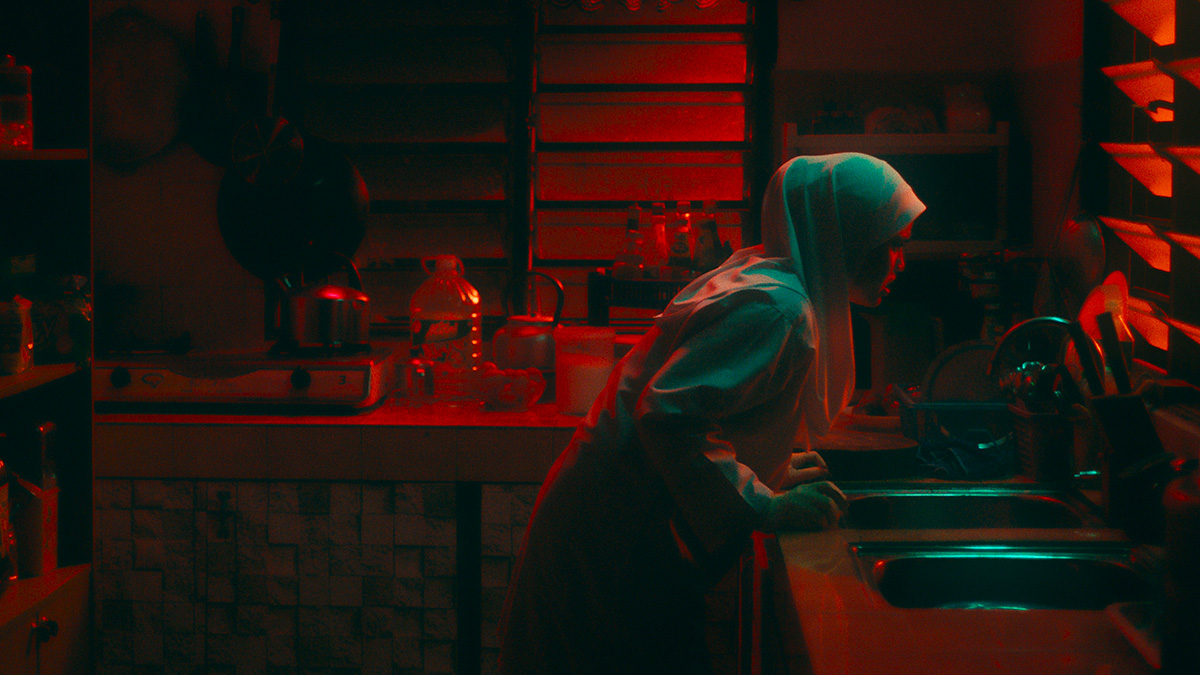Tiger Stripes – Four Ways

The live-editing workshop is an integral part of each year’s Critics Campus, and this year, four members of the cohort were assigned Amanda Nell Eu’s coming-of-age body horror Tiger Stripes. After penning their reviews, the participants sat through an intensive revision session with MIFF Publications & Audience Development Manager and Liminal Publication Editor Adolfo Aranjuez. Read their final reviews below.
By Christy Tan
As 11-year-old Zaffan peels back her fingernail, revealing its raw and exposed underside, I feel the person beside me squirm in their seat. The visceral scene provokes an immediate reaction in the rest of the fully packed cinema. As if in a wave of unanimous disgust, we are transfixed by this unbearable image. Amanda Nell Eu’s debut feature, Tiger Stripes, is a highly sensory experience, the sounds of hair and skin being torn rippling through the shuddering theatre. Sound penetrates and enters its subjects, heightening the collective intimacy of induced repulsion.
Zaffan is getting her period, but this is only the first of many changes she must endure as her body grows increasingly beyond her – or anyone else’s – control. No longer a girl but not quite yet a woman, she becomes a tiger. With her quivering whiskers and rough claws, she defiantly stares back at her enemies through fluorescent pink eyes – like laser beams emitting an untameable wildness – refusing to surrender to the constraints of her patriarchal environment.
Feminist body horror is an apt allegory, not only for the volatility of puberty but also the vilification of women’s bodies. Zaffan learns to experience her body as a site of shame and self-loathing, rigorously attempting to clean the menstrual blood from her pad out of fear that it will attract demons. This appears in stark contrast to her carefree and rebellious nature at the beginning of the film.
As anyone who has been through the ordeal will know, the real horror of being a teenage girl does not come from the body, but from the piercing and relentless scrutiny it attracts. At this age, the borders of Zaffan’s developing identity are at their most porous and susceptible to outside judgement. Her initiation into so-called womanhood is one of internalised misogyny, and although this violence – perpetrated by her classmates and ex-friends – is often lateral, it is also reinforced by the adult figures in her life.
The most comical of these characters is Dr Rahim, the condescending and clueless exorcist recruited by Zaffan’s teachers to quell the mass outbreak of hysteria in the school. The addition of this paternalistic character pokes fun at society’s efforts to domesticate her as she becomes increasingly ungovernable. The hallway is littered with young girls uncontrollably sobbing on the ground, simultaneously inundated with terror from witnessing Zaffan’s disturbing transformation. As Eu oscillates between horror and comedy, the film’s hyperbolic effects and audience response to the feminine frenzy creates an absurd atmosphere. This blending of genres is reflective of the liminality of coming-of-age.
Although the diagnosis of hysteria has historically been weaponised to control women, Eu inverts this misogynistic gaze and instead focuses on the helplessness of the adults in the face of their overwhelming and unruly trauma. Following Dr Rahim’s pitiful attempt to exorcise Zaffan, we see his head rolling across a gravel road, a triumphant Zaffan emerging in full animalistic guise.

Tiger Stripes
By Kevin Bui
The supernatural film, maybe more so than any other subgenre, is constantly in conversation with aspects of religion. Over the years, the mystical nature of this realm of cinema has been deployed to great effect in coming-of-age stories – strange transformations of the teenage body and the worlds they inhabit serving as useful metaphors for the harrowing experience that is puberty. Tiger Stripes, the debut feature from Malaysian director Amanda Nell Eu, doesn’t seek to strike any new ground for those already familiar with such films. Instead, this charming horror-comedy hybrid is largely elevated by the ways in which these conventions contrast with the film’s unique cultural specificities, its more paranormal qualities rubbing against the traditional values and rituals ingrained in its rural-village setting.
When 11-year-old Zaffan experiences her first period, her reaction is, surprisingly, one of relative joy. After getting over the initial shock of waking up on a bloodstained mattress, she goes to school the next day buzzing with excitement. Relieved to escape religious responsibilities like prayer, Zaffan now relishes her sense of superiority over a friend who has been frequently antagonising her.
This first section of the film undoubtedly possesses the most levity. Zafreen Zairizal enthusiastically portrays Zaffan’s inflated confidence; playing the school’s resident troublemaker, she embodies a glee that echoes Brooklynn Prince’s breakthrough performance in Sean Baker’s The Florida Project (2017), a work that similarly explores the highs and lows associated with growing up.
Many coming-of-age films run the risk of using mobile phones and social media culture in a seemingly unnatural or forced manner. In Tiger Stripes, however, the use of digital video contrasts well with the movie’s visual language. Eu and cinematographer Jimmy Gimferrer cleverly weave footage of Zaffan’s TikTok dance videos with the movie’s more formal photography, its warm orange and yellow tones imitating the Malaysian sun, evoking the innocent haze of childhood memories.
Soon enough, rashes appear across Zaffan’s skin, her hair and nails start to fall out, and her breaths begin to sound like snarls. The supernatural elements of the film emerge and highlight the ways in which her bodily transformations alienate her from her friends and family. An already deeply complicated relationship with her mother becomes even more complex when Zaffan gains the unearthly strength to stand up to her. The growing estrangement the young girl is experiencing is reflected most emblematically in a scene in which her cohort lines up outside a prayer room, leaving Zaffan as the only student unable to enter the holy site due to the ‘uncleanliness’ of her period.
Most of the film’s story beats are easy to identify from other works. Late in the movie, a religious celebrity arrives in Zaffan’s village in an attempt to reverse her bodily mutations, calling to mind popular representations of con artists posing as priests. In Tiger Stripes, this familiar trope is given new life in its depiction of a cowardly cleric more concerned with Facebook likes than faith-healing practices. This simple twist encapsulates the film’s greatest strengths, restaging familiar characters and scenarios through the prism of a cinematically vastly underseen community.

Tiger Stripes
By Đăng Tùng Bach
I didn’t expect Tiger Stripes (Amanda Nell Eu, 2023) to take me back to fifth grade in Vietnam. It was a sex-education seminar, and we boys, stupid and rowdy, started wrestling out of boredom. Meanwhile, the girls were being told that they would turn from buds into blooming flowers. And I remember wondering if flowers were all girls could turn into.
Zaffan (Zafreen Zairizal) is a Malaysian girl in fifth grade, and she is the first in her class to go through puberty. But something must be wrong, because Zaffan doesn’t turn into a flower – she turns into something else, something ferocious.
Zaffan is the protagonist of Tiger Stripes, writer/director Eu’s debut feature. Previously, Eu has made short films that also explore the female body, Malay mythology and transformations. Vinegar Baths (2018), for example, is a film about a pregnant woman and an overworked nurse that loosely adapts the myth of the penanggalan, a foetus-feasting midwife. Meanwhile, It’s Easier to Raise Cattle (2017) deals with a friendship between two girls, and I suspect that one of them is a pontianak because she turns into a seductress at night and eats human flesh.
In Tiger Stripes, the gore is implied more than it is shown. Yes, I understand that it’s a film about tweens, but I couldn’t help feeling disappointed that Tiger Stripes didn’t deliver on the ‘body horror’ premise as spectacularly as Eu’s short films did. But what Tiger Stripes lacks in blood and guts, it makes up for in the time it gives its characters. Zaffan’s transformation isn’t immediate; because of that, Eu is able to more effectively portray the character’s journey from rejecting her body to understanding and, ultimately, accepting it.
Time also allows for delicate moments: when light shimmers in Zaffan’s teary eyes the night she wakes up and finds out that she’s had her first period; and when, in a rosy garden, she gently runs her finger down the back of a caterpillar. These moments feel like forever. And when juxtaposed against scenes of electric chaos, they present vulnerability not as a weakness but as the tender heart of the monstrous feminine.
Yes, ‘monstrous’, because Zairizal eats it up as Zaffan. She gets physical – grunting, roaring, crawling, you name it; she’s a real beast. I cannot overstate how much her electrifying presence fuels the film’s intentionally choppy visual effects, which remind me of 1960s Malaysian horror aesthetics.
And, out of nowhere, Shaheizy Sam kicks the door down as Bruce Campbell–esque shaman Dr Rahim. As a rare male figure in the film, he represents the disruptiveness and insensitivity of the outside world towards Zaffan’s relationship with her transforming body. But amid all that, my mind clings to those cutaways of the lush jungles and glossy rivers of Malaysia. In my imagination, those lingering shots are where girls like Zaffan go to, with their beautiful fangs and claws and their Sofia the First backpacks. Over there, they all turn into monstrous tigers and dance together. Because they are free, they are bright and they are gorgeous.
Maybe tigers can be flowers, too.

Tiger Stripes
By Erika Lay
Body shame and self-consciousness are wholly foreign notions to 11-year-old Zaffan (Zafreen Zairizal), who first appears in Tiger Stripes on a phone screen with all the raw exuberance of a performed TikTok dance. Dismissive of the conservative dress code demanded by her school in rural Malaysia, Zaffan charges forwards with steely-eyed rebellion and instigates rounds of roughhousing with friends in shallow jungle streams. That all changes when misfortune strikes in the form of her period, inadvertently catalysing an outbreak that spreads across her all-girls middle school.
In her searing directorial debut, Malaysian-born writer/director Amanda Nell Eu fleshes out the carnal realities of female coming-of-age with an animal-based allegory, lightly flecked with body horror. Trailing the spirited Zaffan, Tiger Stripes likens the symptoms of female puberty to a particularly noxious contagion – with friendship groups as the primary mode of transmission, and symptoms including: striped rashes across the back, torso and arms and the fishy odour of bloody discharge. As Zaffan’s symptoms veer on the sinister, Eu transforms the ambiguous excesses of uncontrolled bodily development into a spectacle of interspecies metamorphosis: in flitting visions, we watch as Zaffan’s nails moult into gnarled, hyper-enlarged claws, and she develops an appetite for raw meat.
The familiarity of Tiger Stripes’ allegory runs bones deep: the figure of the monstrous feminine has mythologised patriarchal fears surrounding the female body across cultures and millennia. It’s a subject that Eu has previously tackled with carnivalesque body horror in her shorts It’s Easier to Raise Cattle (2017) and Vinegar Baths (2018), which satirised the Malaysian mythical figures of the pontianak, a vengeful female spirit unable to give birth, and the penanggalan, which takes the form of a disembodied, floating female head.
A parable of metamorphosis that were to trace the processes of becoming a woman – or, in this case, a carnivorous apex predator – might attempt to reclaim the female body by recapitulating to the deep-seated prowess of the carnal. In Tiger Stripes, however, female coming-of-age is less an affliction of the individual than a communal experience constructed by patriarchal fears; Eu refrains from essentialising emancipatory womanhood as the return of the primal. At turns absurd and sobering, Tiger Stripes satirises its narrative’s contagion with off-the-cuff visual quips, derived from the narcissism of a pseudo-doctor who live streams performances of curing the “infected”, along with all the middling inadequacies of adult helplessness as teachers attempt to manage the contagion.
A cruder portrait of Zaffan’s mutations might have leaned more into its visions of inflamed skin and gorging on a live rodent, self-reflexively gesturing to its artifice. Yet Eu plays deftly with the light-humoured absurdity of the tension between the real and the bodily grotesque. Instead, Tiger Stripes presents a psychorealistic comedy that leans into the uninhibited, ambivalent excesses of body morphing: on the border between human and non-human; between flashes of Zaffan scampering up a tree and the straight-faced cut to her seated in the relative placidity of the classroom. In Tiger Stripes, the bodily grotesque doesn’t so much carnivalise puberty as familiarise the self-alienating excesses of physical growth – a potent allegory of dysmorphic bodily change in general.